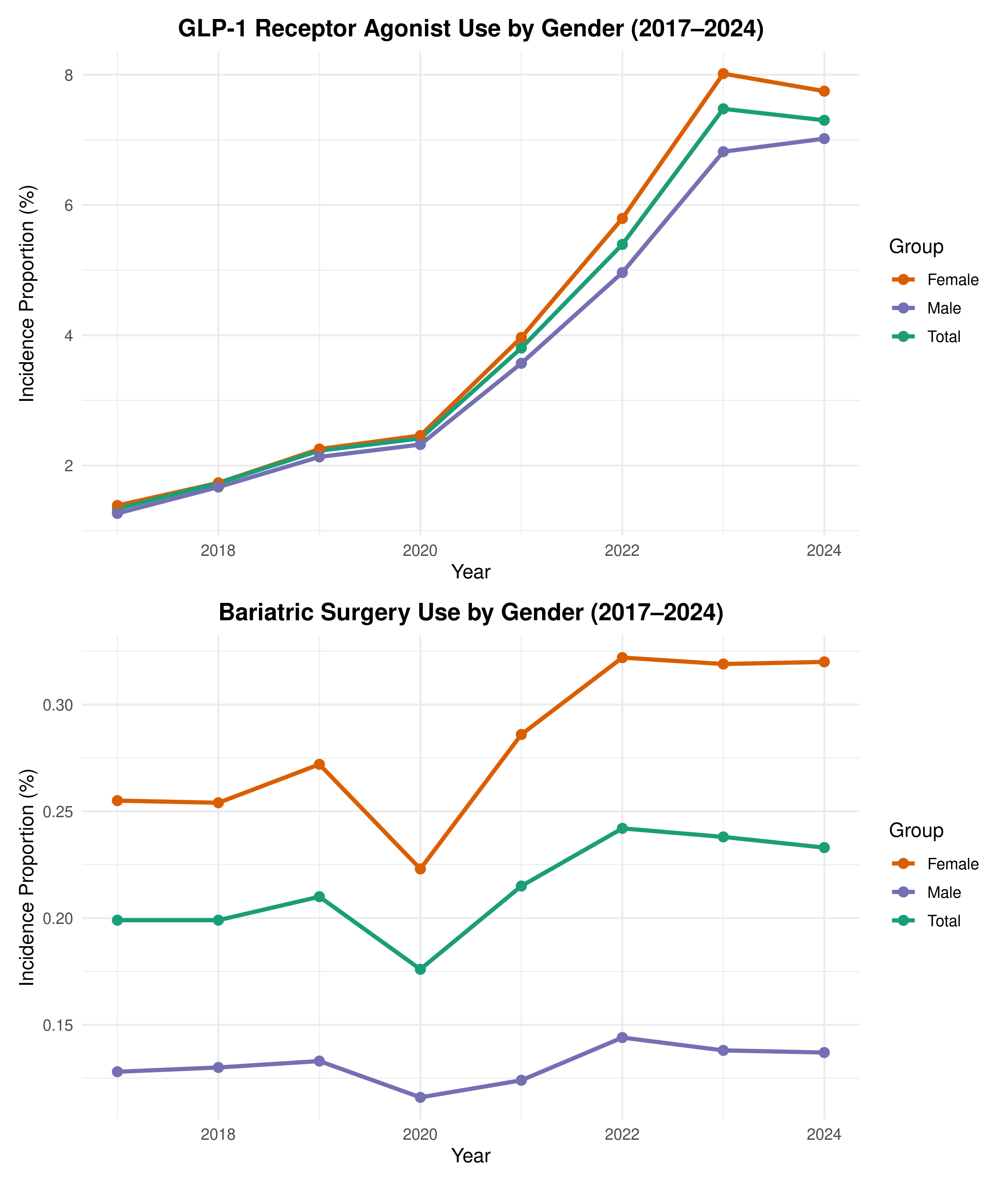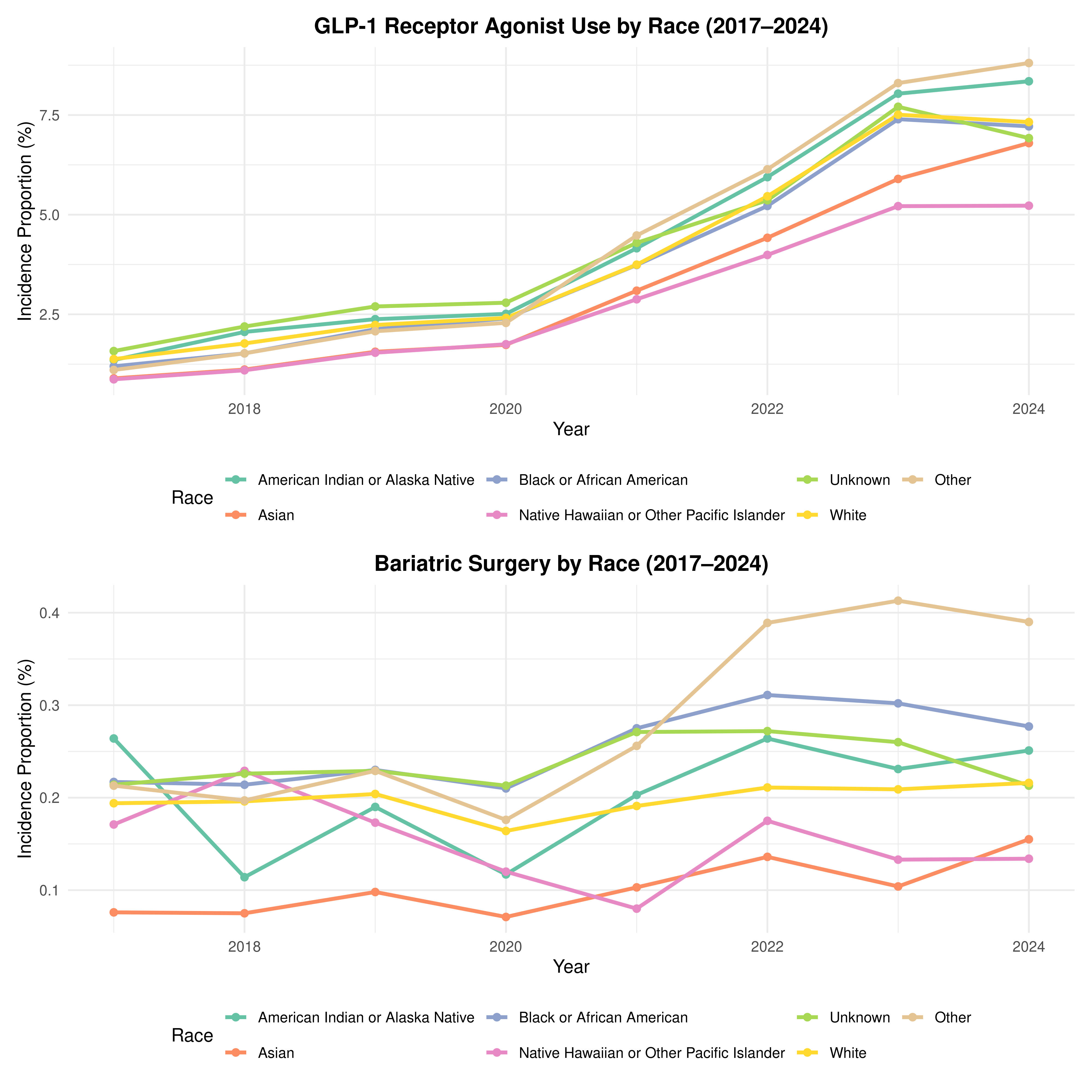Tuesday Poster Session
Category: Diet, Nutrition, and Obesity
P4822 - Temporal Patterns in GLP-1 Receptor Agonist and Bariatric Surgery Use Among Patients With Diabetes Mellitus and Obesity in the United States
Tuesday, October 28, 2025
10:30 AM - 4:00 PM PDT
Location: Exhibit Hall
- OA
Omar Al Ta'ani, MD
Department of Internal Medicine, Allegheny Health Network, Pittsburgh, Pennsylvania, USA
Pittsburgh, PA
Presenting Author(s)
Omar Al Ta’ani, MD1, Saqr Alsakarneh, MD, MSc2, Yahya Alhalalmeh, MD3, Dushyant S. Dahiya, MD4, Mohammad Bilal, MD, FACG5
1Department of Internal Medicine, Allegheny Health Network, Pittsburgh, Pennsylvania, USA, Pittsburgh, PA; 2Mayo Clinic, Rochester, MN; 3New York Medical College - Saint Michael's Medical Center, Newark, NJ; 4University of Kansas School of Medicine, Kansas City, KS; 5University of Colorado Anschutz Medical Campus, Denver, CO
Introduction: Obesity and type 2 diabetes mellitus (T2DM) are growing public health concerns in the United States. Two common interventions for managing these conditions are glucagon-like peptide-1 receptor agonists (GLP-1 RAs) and bariatric surgery. Understanding how the use of these therapies has evolved over time is critical for informing healthcare planning, assessing access and equity, and guiding future policy and clinical decision-making. This study examines national trends in the use of GLP-1 RAs and bariatric surgery among patients with obesity and T2DM.
Methods: We used the TriNetX research network to identify adults with T2DM and a body mass index (BMI) >30 kg/m² between January 1, 2017, and December 31, 2024 in the United States. Annual incidence rates of GLP-1 RAs and bariatric surgery use was determined using relevant ICD and procedure codes. Temporal trends were analyzed, and visualizations were generated using R programming version 4.3.3.
Results: Among 2,650,887 patients with T2DM and obesity from 2017 to 2024, the annual incidence proportion of GLP1-RAs use increased from 1.3% (23,828 patients) in 2017 to a peak of 7.5% (114,028 patients) in 2023, followed by a slight decline to 7.3% (91,731 patients) in 2024, as shown in Figure 1. In 2024, the highest use was observed among patients aged 30–34 years (10.4%), with greater use in females (7.7%) compared to males (7.0%) and lowest among Native Hawaiian or Other Pacific Islander patients (5.2%) as shown in Figure 2. Bariatric surgery incidence remained below 1% throughout the study period, rising from 0.20% in 2017 to 0.23% in 2024. The highest 2024 incidence was among patients aged 25–29 years (0.82%), with higher utilization in females (0.32%) than males (0.14%).
Discussion: Between 2017 and 2024, the use of GLP-1-RAs among U.S. adults with obesity and T2DM increased substantially, particularly among younger adults and females. These trends suggest a growing preference for pharmacologic rather than surgical interventions and underscore the need to evaluate long-term outcomes, cost-effectiveness, and equitable access to both treatment modalities.

Figure: Figure 1: Trends in GLP-1 Receptor Agonist and Bariatric Surgery Use by Gender in the United States (2017–2024)

Figure: Figure 2: Trends in GLP-1 Receptor Agonist and Bariatric Surgery Use by Race in the United States (2017–2024)
Disclosures:
Omar Al Ta’ani indicated no relevant financial relationships.
Saqr Alsakarneh indicated no relevant financial relationships.
Yahya Alhalalmeh indicated no relevant financial relationships.
Dushyant Dahiya indicated no relevant financial relationships.
Mohammad Bilal: Boston Scientific – Consultant. Cook endoscopy – Paid speaker. Steris Endoscopy – Consultant.
Omar Al Ta’ani, MD1, Saqr Alsakarneh, MD, MSc2, Yahya Alhalalmeh, MD3, Dushyant S. Dahiya, MD4, Mohammad Bilal, MD, FACG5. P4822 - Temporal Patterns in GLP-1 Receptor Agonist and Bariatric Surgery Use Among Patients With Diabetes Mellitus and Obesity in the United States, ACG 2025 Annual Scientific Meeting Abstracts. Phoenix, AZ: American College of Gastroenterology.
1Department of Internal Medicine, Allegheny Health Network, Pittsburgh, Pennsylvania, USA, Pittsburgh, PA; 2Mayo Clinic, Rochester, MN; 3New York Medical College - Saint Michael's Medical Center, Newark, NJ; 4University of Kansas School of Medicine, Kansas City, KS; 5University of Colorado Anschutz Medical Campus, Denver, CO
Introduction: Obesity and type 2 diabetes mellitus (T2DM) are growing public health concerns in the United States. Two common interventions for managing these conditions are glucagon-like peptide-1 receptor agonists (GLP-1 RAs) and bariatric surgery. Understanding how the use of these therapies has evolved over time is critical for informing healthcare planning, assessing access and equity, and guiding future policy and clinical decision-making. This study examines national trends in the use of GLP-1 RAs and bariatric surgery among patients with obesity and T2DM.
Methods: We used the TriNetX research network to identify adults with T2DM and a body mass index (BMI) >30 kg/m² between January 1, 2017, and December 31, 2024 in the United States. Annual incidence rates of GLP-1 RAs and bariatric surgery use was determined using relevant ICD and procedure codes. Temporal trends were analyzed, and visualizations were generated using R programming version 4.3.3.
Results: Among 2,650,887 patients with T2DM and obesity from 2017 to 2024, the annual incidence proportion of GLP1-RAs use increased from 1.3% (23,828 patients) in 2017 to a peak of 7.5% (114,028 patients) in 2023, followed by a slight decline to 7.3% (91,731 patients) in 2024, as shown in Figure 1. In 2024, the highest use was observed among patients aged 30–34 years (10.4%), with greater use in females (7.7%) compared to males (7.0%) and lowest among Native Hawaiian or Other Pacific Islander patients (5.2%) as shown in Figure 2. Bariatric surgery incidence remained below 1% throughout the study period, rising from 0.20% in 2017 to 0.23% in 2024. The highest 2024 incidence was among patients aged 25–29 years (0.82%), with higher utilization in females (0.32%) than males (0.14%).
Discussion: Between 2017 and 2024, the use of GLP-1-RAs among U.S. adults with obesity and T2DM increased substantially, particularly among younger adults and females. These trends suggest a growing preference for pharmacologic rather than surgical interventions and underscore the need to evaluate long-term outcomes, cost-effectiveness, and equitable access to both treatment modalities.

Figure: Figure 1: Trends in GLP-1 Receptor Agonist and Bariatric Surgery Use by Gender in the United States (2017–2024)

Figure: Figure 2: Trends in GLP-1 Receptor Agonist and Bariatric Surgery Use by Race in the United States (2017–2024)
Disclosures:
Omar Al Ta’ani indicated no relevant financial relationships.
Saqr Alsakarneh indicated no relevant financial relationships.
Yahya Alhalalmeh indicated no relevant financial relationships.
Dushyant Dahiya indicated no relevant financial relationships.
Mohammad Bilal: Boston Scientific – Consultant. Cook endoscopy – Paid speaker. Steris Endoscopy – Consultant.
Omar Al Ta’ani, MD1, Saqr Alsakarneh, MD, MSc2, Yahya Alhalalmeh, MD3, Dushyant S. Dahiya, MD4, Mohammad Bilal, MD, FACG5. P4822 - Temporal Patterns in GLP-1 Receptor Agonist and Bariatric Surgery Use Among Patients With Diabetes Mellitus and Obesity in the United States, ACG 2025 Annual Scientific Meeting Abstracts. Phoenix, AZ: American College of Gastroenterology.
